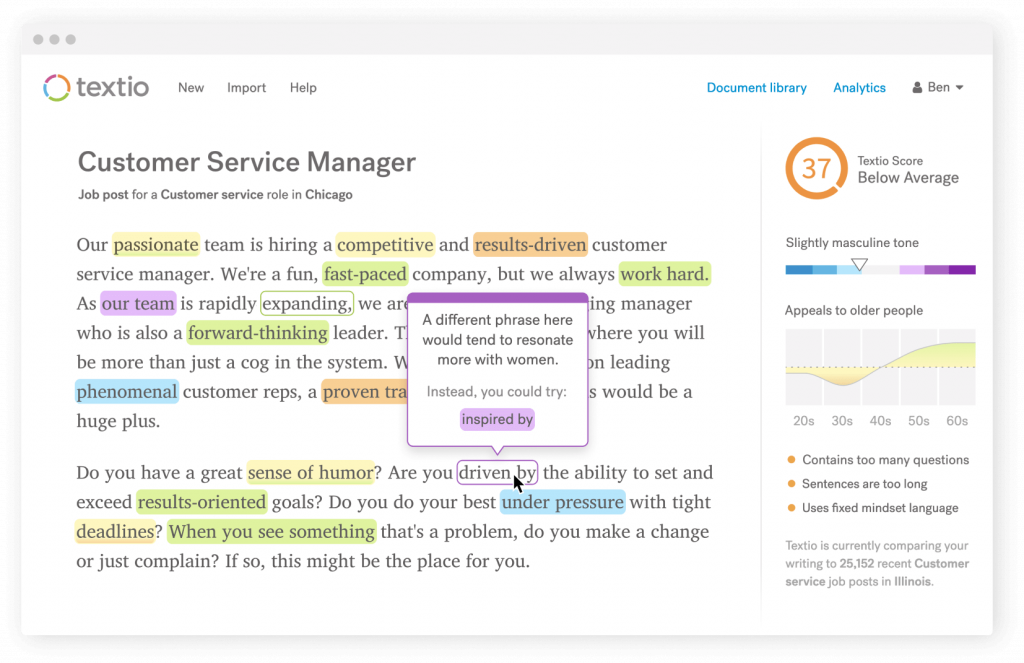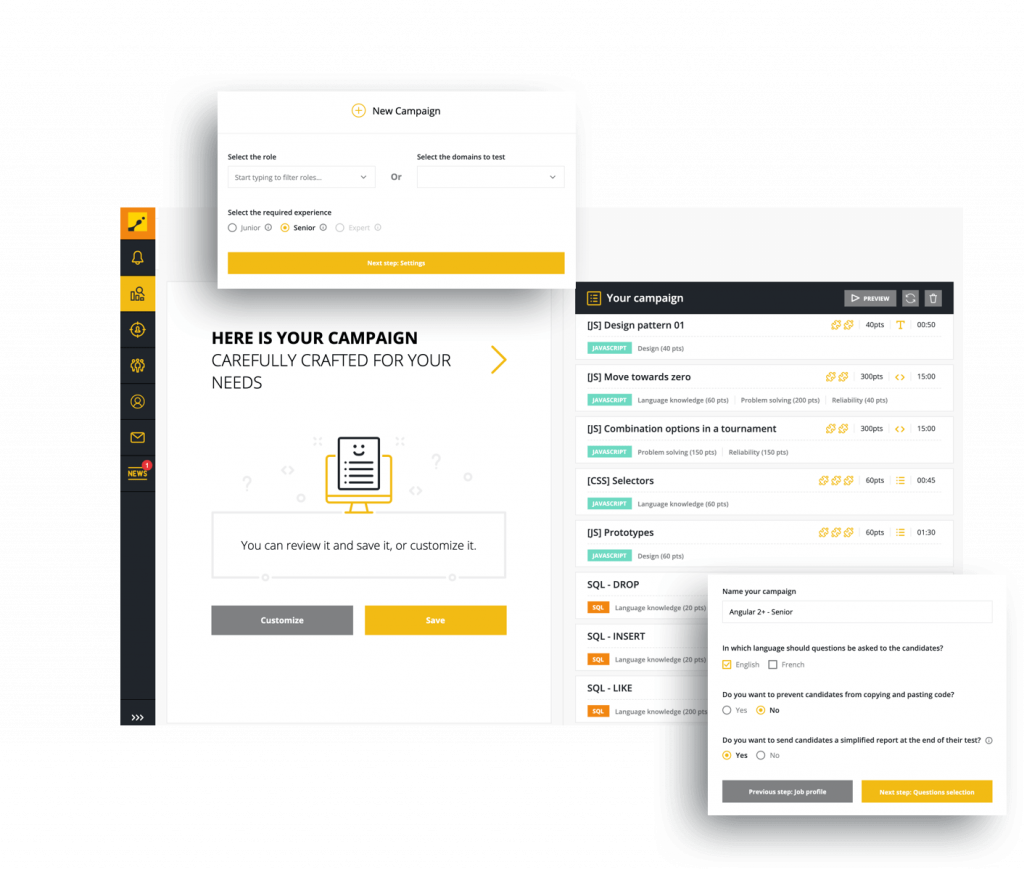We’d like to believe that we’re always fair and objective when evaluating and selecting candidates. After all, we have the very best intentions.
Unfortunately, we’re also human. This means we sometimes use mental shortcuts without realizing or fall prey to cognitive biases.
When researchers send resumes out, Latisha and Jamal get fewer callbacks than Emily and Greg despite the same apparent experience and qualifications. Adam is offered 12 interviews and Mohamed 4. A candidate whose education and experience took place in another country gets less interest than one whose resume only shows local locations.
These studies’ results are mirrored in real-world data, such as an analysis of behavior on a Swiss job site. They found a job candidate from Sub-Saharan Africa was 17% less likely to be contacted than one from Switzerland.
Even companies who have increased diversity as a goal and report on it regularly, fall short. At Google, only one-third of hires are women and the number of black employees at Facebook only increased from 3% to 3.8% in 6 years. It’s no wonder 66% of recruiters agree that bias is an issue in tech recruiting.
Types of bias
Affinity bias
Affinity bias occurs when we prefer people who are similar to us. Perhaps the candidate went to the same university or comes from the same town. We might also prefer people who are similar to existing employees, under the guise of seeking culture fit. In a startup full of young interns, a recruiter might assume that an employee in his fifties would not fit in as well, for example (of course, salary expectations are also used as a justification for age discrimination).
Often these surface demographics, such as age, race, sex, gender, or appearance, can be surmised from a resume or LinkedIn profile. As this is often the first point of filtering for many recruiters, it means some people might not get the chance to show their skills during a work test or sell themselves during an interview.
Affinity bias can also come into play during interviews when interpersonal aspects are on display. We click better with some people than others. Some people are more at ease during interviews than others and better able to communicate their competencies as a result.
The halo effect
The halo effect also comes into play in such situations. The halo effect means that we notice one positive attribute and it then colors our perceptions in a positive manner. This could be physical appearance, where an attractive candidate is assumed to be more competent. Even height plays a factor. Research has found that someone who is 6 feet tall (182.88 cm) will earn $166,000 more on average than someone who is 5 feet 5 inches (165 cm) tall over a 30-year career. It could also be an impressive company or university name on a resume that primes us to assume the best of the person.
Heuristics
We also use mental shortcuts, or heuristics, to make judgments. This could mean seeing a well-reputed school or the name of a famous company on a resume and assuming this translates into competence in the very skills you are seeking. While this may help identify some great candidates, it also excludes others who have the same abilities but lack the glittering references on the resume.
Knowing that we have our human mental flaws that interfere with objectivity, people have tried to develop AI to simplify recruiting. Unfortunately, AI is developed by feeding it with material based on what we do and can therefore develop the same biases. When Amazon tried using AI for hiring it started preferring men for technical jobs and was quickly abandoned.
What are the advantages for companies to reducing bias?

When you reduce bias in recruiting, you can create more diverse teams. Diverse teams are good for problem-solving, innovation, and thoughtful strategic planning. This translates into better results for companies. Highly gender-diverse tech companies returned on average 5.4% more on an annual basis than companies with less gender diversity. A recent study also found that companies that discriminate based on race are also less profitable.
Diverse companies are also more attractive to candidates. In a 2021 Beqom survey, 48% of respondents said they would consider moving to another company if it had a well-developed Diversity, Equity and Inclusion (DEI) policy. This can be especially important for millennials. According to a Deloitte survey, 83% of whom feel empowered and engaged in the workplace when they believe their company fosters an authentically inclusive culture.
Best practices to remove bias from your recruitment process
Raise awareness and make diversity a goal
It is unlikely anyone is purposely preferring certain candidates, it’s generally subtle and unconscious. If we prefer one candidate to another due to unconscious biases, we still come up with rational reasons and don’t even realize we were influenced by other factors. To get people thinking about how they might have implicit biases they don’t realize, you can share the Harvard Implicit Association test.
You can then decide as a company or a team that reducing bias and increasing diversity is a priority. Emphasize the benefits for the company in addition to issues of fairness. Everybody’s goal is to have the best candidates and it’s important to find ways to identify the best without being blinded by mental shortcuts that lead to always hiring the same type of profile.
It’s important to streamline the recruiting process and have clearly defined standards as much as possible. This way the selection process can be similar among different recruiters. Perhaps the candidate who is changing career and learned to code in a boot camp is the better choice than the person who benefited from the halo effect with Google listed on a resume as a previous employer.
Rewrite your job descriptions
Depending on what you write in your job description, people will decide whether or not to apply. It is therefore the first chance to try to attract a diverse group of people who would do well at the post. If a job ad becomes a wishlist of nice-to-have skills, which are not necessarily obligatory to succeed in the job, some people will feel confident applying even if they don’t have all the skills but many others won’t. This is especially true for women, who are less likely to apply if they don’t feel they fit all the requirements on a job ad.
Another way that the content of job ads can influence who applies for the position, is the choice of words. Research has shown that some words draw more female applicants and others reduce their numbers. Particularly, words associated with male stereotypes, such as leader, competitive, and dominant, make jobs sound less appealing to women than words associated with female stereotypes, such as support, understand, and interpersonal. Posting for a coding ninja might add a fun touch to a job description but change the mix of who applies.

When one recruiter posted two consecutive ads for an office manager, a difference in wording resulted in applicants for the first ad being 33% women and only 8% for the second ad. Atlassian, an Australian software company, used AI software Textio to ensure job-ad copy that was more balanced to appeal to women as much as men and saw an 80% increase in the hiring of women for technical roles over a two-year period. Additionally, the word stakeholder apparently “serves as a signal to people of color that their contributions may not be valued” according to Aubrey Blanche, Atlassian’s global head of diversity and belonging. “We don’t know why, but this is what the data shows.”
Textio found that gendered language used in a job post predicts the people who are likely to apply and thus be hired. Having twice as many masculine-tone phrases (such as exhaustive, enforcement, and fearless) in an ad results in a man being hired and twice as many feminine-phrases (such as transparent, catalyst, and in touch with) a woman. So the bias in the very job ad predicts who will finally be hired.
Give a work sample test
To get an idea of whether a candidate has certain skills, we often look at experience and education, but these are just proxies for skills. Instead, you should actually verify the skills you need by testing potential employees on tasks or problems that are directly relevant to the job they will do.
The task or test should be something that can be graded objectively to fairly compare candidates. If you have different tasks or questions, you can anonymize them and then divide them to compare results between candidates for each one. It’s easier to grade fairly when comparing part by part. If scoring is required, you can involve more than one person and then average the scores so it’s not dependent just on one person’s opinion.

If you use a tool with relevant questions, such as a technical test from CodinGame, you can save yourself time by getting detailed results, a comparison score, and a ranking. You can even anonymize the reports when sharing to decide on which candidates really stand out. You can even use the code playback to see how candidates code and get a much deeper insight than just the score.
Structure interviews
Many times interviews vary from candidate to candidate for the same post, as interviewers react to details on a resume or ask further questions based on the candidate’s answers. While this can feel like a good approach to capture each candidate’s unique advantages, the downside is that the variation makes the process no longer completely equal or comparable. One interview might take a tangent and result in a few minutes spent on the potential employee’s volunteer experience in an unrelated field and this information can still sway the decision-making process, despite not being directly relevant to the role.
Our opinions are also swayed by peaks and endings. So if one interview had a brief high point where a moment was shared on an unrelated topic, this could create a lasting more positive impression, regardless of the rest of the interview. Also, an interview ending on a particularly high point will leave a more positive impression so it is important to not be ending each interview with different questions or small talk.

Casual interviews of these types are not good for predicting job success. Instead, you should carefully structure the interviews by preparing questions in advance and sticking to the same questions for each candidate. You also need to decide on the criteria to judge the responses to these questions. Also, a scoring system to know the weighting of each question and what is required to get a certain score. This might be a detail, such as a candidate mentioning Agile in an answer getting 3 points.
Marina Murashev, senior engineer at CoderPad, recommends recording meetings or taking comprehensive notes to come back to with a fresh perspective the next day. You can also invite a person to the interview who didn’t participate in the initial selection process. A person who didn’t see the resume or pre-test results can give an additional impartial point of view.
Don’t filter candidates when you’re tired
When you’re tired at the end of a long workday, you’re more likely to rely on mental shortcuts and biases. This is because we experience decision fatigue. In one study, bias increased by 20% when recruiters reviewed candidates on a job site at the end of the workday. Another study found that interviewers took more time to evaluate early on but for later interviews, they evaluated more quickly. Doing structured interviews was able to somewhat counteract this tendency as it encouraged interviewers to take more time on their evaluation.

To avoid the impact of decision fatigue, try to filter candidates and do interviews earlier in the day, when possible. When it’s necessary to do it later, have a coffee or a quick walk around the office to wake yourself up before tackling the task, and be aware that you’re more likely to rush evaluations at this time.
Decide on the importance of likeability and culture fit
It is natural that some candidates will just be more likable to you than others. You need to decide whether this should be a factor to take into consideration when deciding which candidate to choose. It is easy to associate likability with culture fit, assuming the candidate who is more likable will also fit better into company culture. But likeability can be influenced by something as simple as seeing the candidate’s photo on LinkedIn and forming a judgment. In one study, participants saw photos of women and judged them on several criteria and then met them in person 1-6 months later and formed the same opinions.
Realizing the fallibility of these criteria, you can decide the weighting for it among other criteria, to be sure that it doesn’t take too large of a place.
Takeaways
- Raise awareness of biases in recruiting and get buy-in from those involved in the process. Everybody wins from fairer hiring and greater diversity.
- Pay attention to language when writing job descriptions so they aren’t gender-biased. Also, focus only on the skills necessary for the job.
- Test candidates on skills and tasks directly relevant to the job rather than rely on CVs or first impressions.
- Do structured interviews with set questions and a grading criteria. Involve new people in the interview to get an additional impartial viewpoint.
- Don’t filter them at the end of the day or plan too many interviews in a row without a break. This will give candidates a fairer chance.
- Make sure that likeability doesn’t take up more place than it should in hiring decisions.

